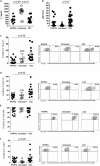Decreased Neurofilament L Chain Levels in Cerebrospinal Fluid and Tolerogenic Plasmacytoid Dendritic Cells in Natalizumab-Treated Multiple Sclerosis Patients - Brief Research Report
- PMID: 34381335
- PMCID: PMC8350727
- DOI: 10.3389/fncel.2021.705618
Decreased Neurofilament L Chain Levels in Cerebrospinal Fluid and Tolerogenic Plasmacytoid Dendritic Cells in Natalizumab-Treated Multiple Sclerosis Patients - Brief Research Report
Abstract
Background: Neurofilament Light (NfL) chain levels in both cerebrospinal fluid (CSF) and serum have been correlated with the reduction of axonal damage in multiple sclerosis (MS) patients treated with Natalizumab (NTZ). However, little is known about the function of plasmacytoid cells in NTZ-treated MS patients.
Objective: To evaluate CSF NfL, serum levels of soluble-HLA-G (sHLA-G), and eventual tolerogenic behavior of plasmacytoid dendritic cells (pDCs) in MS patients during NTZ treatment.
Methods: CSF NfL and serum sHLA-G levels were measured using an ELISA assay, while pDCs (BDCA-2+) were accessed through flow cytometry analyses.
Results: CSF levels of NfL were significantly reduced during NTZ treatment, while the serum levels of sHLA-G were increased. Moreover, NTZ treatment enhanced tolerogenic (HLA-G+, CD274+, and HLA-DR+) molecules and migratory (CCR7+) functions of pDCs in the peripheral blood.
Conclusion: These findings suggest that NTZ stimulates the production of molecules with immunoregulatory function such as HLA-G and CD274 programmed death-ligand 1 (PD-L1) which may contribute to the reduction of axonal damage represented by the decrease of NfL levels in patients with MS.
Keywords: HLA-DR; HLA-G; PD-L1; cerebrospinal fluid; neurofilament light chain; neuroinflammation.
Copyright © 2021 Moraes, Boldrini, Dionete, Andrade, Longhini, Santos, Lima, Silva, Dias Carneiro, Quintiliano, Ferrari, Damasceno, Pradella, Farias, Tilbery, Domingues, Senne, Fernandes, von Glehn, Brandão, Stella and Santos.
Conflict of interest statement
LS received a research grant from BIOGEN and a consultation honorarium from BIOGEN and ROCHE. The remaining authors declare that the research was conducted in the absence of any commercial or financial relationships that could be construed as a potential conflict of interest.
Figures

References
-
- Damasceno A., Dias-Carneiro R. P. C., Moraes A. S., Boldrini V. O., Quintiliano R. P. S., da Silva VAPG, et al. (2019). Clinical and MRI correlates of CSF neurofilament light chain levels in relapsing and progressive MS. Mult. Scler. Relat. Disord. 30 149–153. 10.1016/j.msard.2019.02.004 - DOI - PubMed
LinkOut - more resources
Full Text Sources
Research Materials

